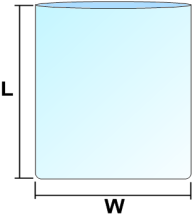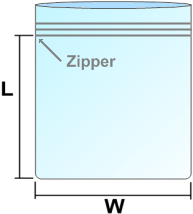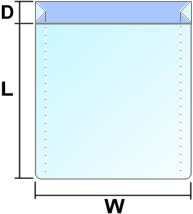In the standard format for describing a bag:
- the width of the bag is always taken to be the side that opens, so this is normally, but not necessarily, the shorter side.
- the width of the bag is given before the length.
- the thickness of the bag is given last and is usually expressed in 'gauge' (100 gauge = 1/1000 of an inch).
- hence the size of a bag is given as: Width (inches) x Length (inches) x Thickness (Gauge).
Flat Bags
Ziplock Bags
For example: if a bag is said to be 4" x 6" x 150 gauge then the bag is 4" wide by 6" long with 150 gauge thickness and the bag will open on the 4" width.
How thick is thick?
100 gauge - a 1/1000 of an inch.
120 gauge - 'light duty' - good for protective covering.
250 gauge - 'medium duty' - good for holding light materials.
500 gauge - 'heavy duty' - where strength is required.
Metric and Imperial - a complication!
Most measurements are given in imperial (inches and gauge) but some of us prefer to use metric scales and the conversions are as follows:
1" = 25.4 mm
400 gauge = 100 micron
For example: a 4"x 6" x 150 gauge bag is the same as a 102mm x 152mm x 37.5 micron bag.
Gussets - a complication!
Some bags have a gusset at the sides to help the bag open out more and enable a greater volume of items to be put in - a good example is a refuse sack. Others have a gusset at the bottom to enable a wide product to fit in - a good example is a carrier bag.
Gussted Bags
- A side gusset is expressed as a bag being x" wide opening to y" wide. For example: if a refuse sack is 16 x 25" x 39" this means it is 16" wide opening to 25" wide when the gusset is opened, with a bag length of 39"
- A bottom gusset is expressed as + x". For example: if a carrier bag is 15" x 18" + 3" then the carrier is 15" wide by 18" long with a bottom gusset of 3".
D - Total depth
L - Length
W - Width
We very much hope this helps but if you require any help or have any questions please call 01749373738 and talk to one of our experts!



No comments:
Post a Comment